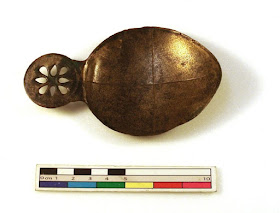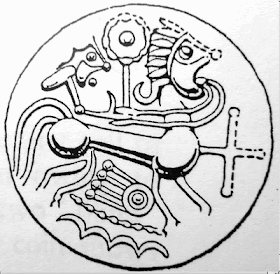 |
Gold-plated copper alloy core of an Iceni stater, the gold foil scored with a
cross. Amusingly, it was found near Fakenham, Norfolk
|
The photographer of the coin saw a cross and not an X because of the way the obverse side of the coin is aligned, but we have no way of knowing how the die cutter aligned the obverse design of the coin. Was it seen as a cross composition or as an X?
 |
| Celtic "ritual" spoon photo: © Trustees of the British Museum |
The object on the left is commonly known as a Celtic ritual spoon, and most of them bear this cross design. The term "ritual: is applied because we know nothing of the original function of these objects. Perhaps they are not ritual at all and were used in some sort of divination. This would not be a ritual application in any prehistoric society, it would be a practical application as there was no separation of the practical and the religious. That separation is a more modern concept.
The cross as a symbol is also used elsewhere in Celtic iconography such as this Coriosolite coin, where the design might also double as the pole and either yoke or swingle-tree of a chariot, but it can also be aligned as an X and can be enclosed within a circle or a rectangle. The Medieval Celtic cross where a smaller circle is superimposed at the junction is probably an example of syncretism and we also see many examples of ancient religious sites that have been adapted by later religions. So we can better assume that the cross cut into the foil of the plated stater was not a symbol of it being false but that it had been used as a sacrifice. (I would not say "offering" because that assumes a recipient and there is no evidence for such in any prehistoric Celtic site). That the sacrifice was carried out at a religious site and that such religious sites were utilized by religions who did make offerings to some god or another is a non-sequitur which fails to understand the processes and purposes of syncretism. The lack of such specificity can result in something like "Chinese whispers" where, after successive alterations, sheer nonsense is written.
"Excluding hoards, only 29% of gold find locations are demonstrably sites (and many of the coins are plated), as against nearly 80% for the other metals. Most gold was evidently deposited away from settlement, although there is a general emphasis on the major river valleys and the coastal strip which may reflect the overall population density and/or the continental origin of much of it. Many finds, however, are actually from wet places, almost certainly deposited in or beside the water, as much prestige metalwork also was."
Colin Haselgrove, Iron Age coins and archaeology, in Celtic Coinage Britain and Beyond, BAR British Series 222, 1992, p.128We also have to take into consideration that there will, of course, be more examples of such sacrifices where there were more people. In modern times, people frequently go for picnics in the country but you will find much more evidence for picnics in a city park than you will at any random spot in the countryside.
I find it interesting that the over all distribution patterns for Celtic coins in Britain is the same for that of brooches, and that brooches are often found broken (in ancient times, not just by the plough) just as earlier sacrifices of swords etc. are bent in similar depositions. This is taken to mean that they were either "ritually killed" or were being prevented from being re-used. Some gold-plated copper alloy cores of coins have their foil nicked to show the internal metal. Also, many of the dies used in these plated coins are the same as those used in non-plated examples and I once owned a plated Iceni Freckemham stater which was not only by the same die cutter as an unplated example, but also showed stylistic evolution so the die cutter was working on dies used for plated and non plated coins at the same time. It seems very likely that the plated coins were intended to deceive. That so many plated gold coins exist and that these coins primary uses were as military pay or for securing allegiances would strongly suggest that they were not forgeries at all. You really do want to annoy anyone with a weapon in their hand, or someone you hope to help rid you of your enemies some day. The use of less valuable sacrifices is in order with later religious practices where the symbol was the thing. The way of determining authenticity and metal value in an economic sense was with chisel cuts (called "test-cuts") into the fabric of the coin to reveal the internal metal Instead of these plated coins being forgeries, I argue for a greater usage as religious/social tokens.
I will be back with more in this series on Monday. Forge ahead and have a genuinely great weekend.
John's Coydog Community page

No comments:
Post a Comment